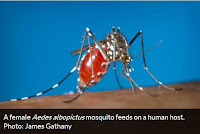Published: 10 February 2016
A report from the Argentine doctors’ organisation, Physicians in the Crop-Sprayed Towns,[1] challenges the theory that the Zika virus epidemic in Brazil is the cause of the increase in the birth defect microcephaly among newborns.
The increase in this birth defect, in which the baby is born with an abnormally small head and often has brain damage, was quickly linked to the Zika virus by the Brazilian Ministry of Health. However, according to the Physicians in the Crop-Sprayed Towns, the Ministry failed to recognise that in the area where most sick people live, a chemical larvicide that produces malformations in mosquitoes was introduced into the drinking water supply in 2014. This poison, Pyriproxyfen, is used in a State-controlled programme aimed at eradicating disease-carrying mosquitoes.
The Physicians added that the Pyriproxyfen is manufactured by Sumitomo Chemical, a Japanese "strategic partner" ofMonsanto. Pyriproxyfen is a growth inhibitor of mosquito larvae, which alters the development process from larva to pupa to adult, thus generating malformations in developing mosquitoes and killing or disabling them. It acts as an insect juvenile hormone or juvenoid, and has the effect of inhibiting the development of adult insect characteristics (for example, wings and mature external genitalia) and reproductive development. It is an endocrine disruptor and is teratogenic (causes birth defects), according to the Physicians.
The Physicians commented: “Malformations detected in thousands of children from pregnant women living in areas where the Brazilian state added Pyriproxyfen to drinking water are not a coincidence, even though the Ministry of Health places a direct blame on the Zika virus for this damage.”
They also noted that Zika has traditionally been held to be a relatively benign disease that has never before been associated with birth defects, even in areas where it infects 75% of the population.
READ MORE
A report from the Argentine doctors’ organisation, Physicians in the Crop-Sprayed Towns,[1] challenges the theory that the Zika virus epidemic in Brazil is the cause of the increase in the birth defect microcephaly among newborns.
The increase in this birth defect, in which the baby is born with an abnormally small head and often has brain damage, was quickly linked to the Zika virus by the Brazilian Ministry of Health. However, according to the Physicians in the Crop-Sprayed Towns, the Ministry failed to recognise that in the area where most sick people live, a chemical larvicide that produces malformations in mosquitoes was introduced into the drinking water supply in 2014. This poison, Pyriproxyfen, is used in a State-controlled programme aimed at eradicating disease-carrying mosquitoes.
The Physicians added that the Pyriproxyfen is manufactured by Sumitomo Chemical, a Japanese "strategic partner" ofMonsanto. Pyriproxyfen is a growth inhibitor of mosquito larvae, which alters the development process from larva to pupa to adult, thus generating malformations in developing mosquitoes and killing or disabling them. It acts as an insect juvenile hormone or juvenoid, and has the effect of inhibiting the development of adult insect characteristics (for example, wings and mature external genitalia) and reproductive development. It is an endocrine disruptor and is teratogenic (causes birth defects), according to the Physicians.
The Physicians commented: “Malformations detected in thousands of children from pregnant women living in areas where the Brazilian state added Pyriproxyfen to drinking water are not a coincidence, even though the Ministry of Health places a direct blame on the Zika virus for this damage.”
They also noted that Zika has traditionally been held to be a relatively benign disease that has never before been associated with birth defects, even in areas where it infects 75% of the population.
READ MORE

Comment